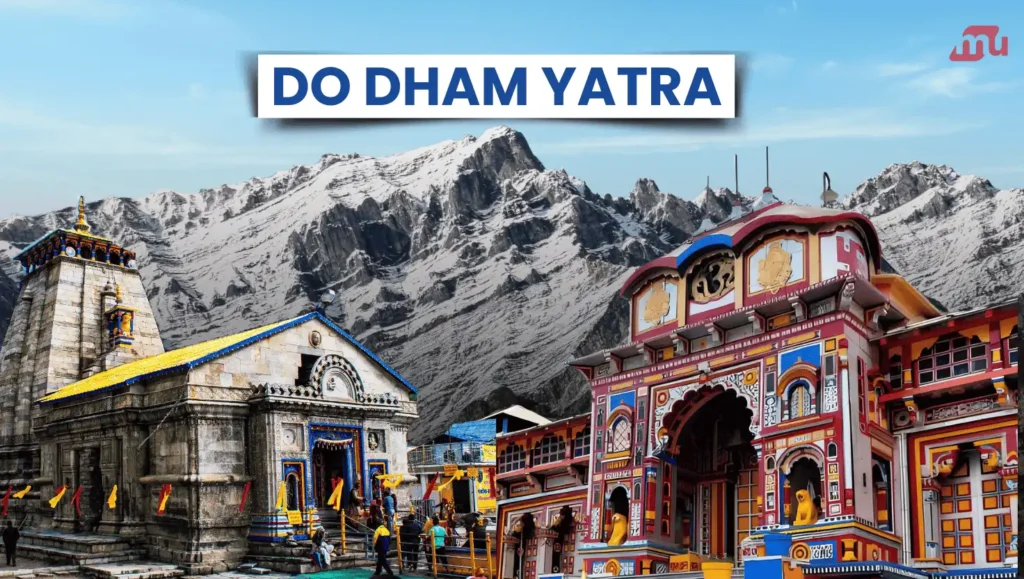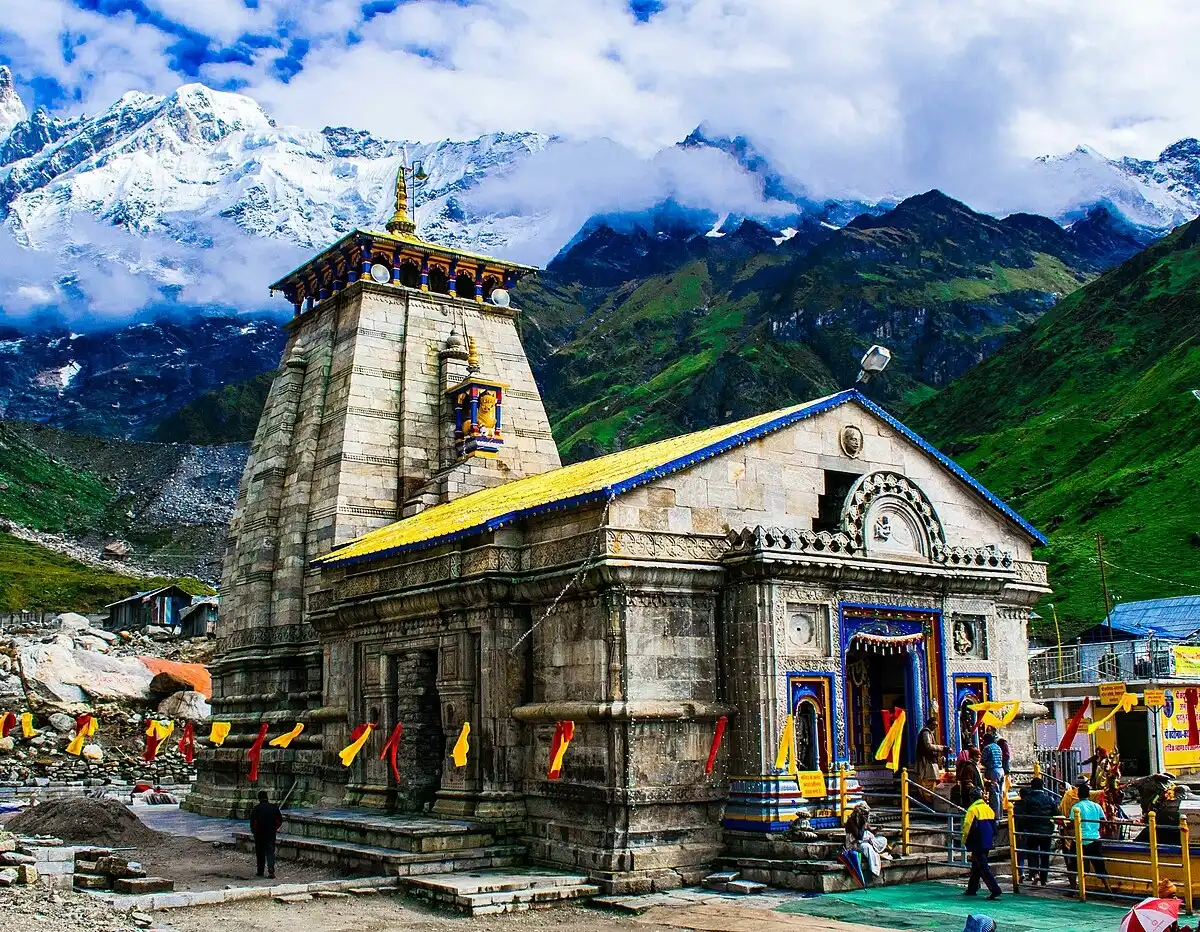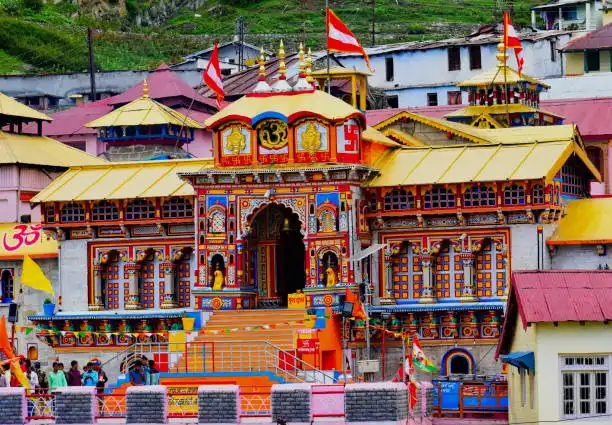Do Dham Yatra Uttarakhand
Roshni Dimri, 7 months ago, 8 min read, 163 Views

Overview of Do Dham Yatra Uttarakhand
One of the most respected pilgrimages in Hinduism is the Do Dham Yatra Uttarakhand. Two of the holiest sites in Hinduism, Badrinath and Kedarnath, are visited during the Yatra. A Do Dham Yatra is thought to be able to cleanse you of all your sins and put you on the road to salvation.
According to the temple’s stories, Lord Shiva pretended to be a bull in order to evade the Pandavas, who wanted to ask him to spare them from the guilt of murdering their blood relatives, the Kauravas.
History of Do Dham Yatra Uttarakhand
Ancient Hindu texts, mythology, and India’s spiritual development all play a significant role in the history of the Do Dham Yatra, which includes Kedarnath and Badrinath. Millions of devotees visit these two hallowed temples annually in search of salvation and heavenly benefits because of their timeless significance. Let’s explore the intricate mythical and historical stories that have influenced Kedarnath and Badrinath’s popularity in Hinduism.
Kedarnath Temple: History and Legends

Origins in Mythology
The Pandavas, the main protagonists of the epic, and the Mahabharata are entwined with the history of Kedarnath. The Pandavas attempted to atone for their transgressions, which included violence and fratricide, after the Kurukshetra War. They went to Lord Shiva to ask for forgiveness. However, Lord Shiva disguised himself as a bull and escaped to the Himalayas since he was unwilling to forgive them.
The Pandavas were able to identify Shiva in his bull form at Kedarnath. When Lord Shiva realized this, he plunged under the earth, exposing just his hump. At Kedarnath, this hump was venerated as the lingam. The Panch Kedar was formed by the appearance of Shiva’s other body parts in various places. As a result, the Kedarnath temple was built where Shiva’s hump appeared.
Kedarnath was created during the Satya Yuga, according to another tradition, and is considered sacred long before human history since Lord Shiva is said to have lived there in the form of light and consciousness.
Historical Significance
Although the Kedarnath temple’s precise beginnings are still unknown, Adi Shankaracharya’s work in the eighth century is generally credited with creating its current design. According to legend, the renowned Hindu scholar and philosopher brought the temple back to life and made it one of the twelve Jyotirlingas, or Lord Shiva’s holiest temples.
Since Adi Shankaracharya sought to unite Hinduism by creating important pilgrimage sites throughout India, his impact went beyond the temple. As a vital component of this spiritual network, Kedarnath drew followers from all over the nation. A memorial now stands at the location where Adi Shankaracharya is said to have achieved Samadhi, or ultimate nirvana, next to the Kedarnath temple.
Since the temple has endured natural disasters for millennia, its construction is a testament to its tenacity. The architecture of the temple, which was constructed with big, uniformly cut grey stones, enables it to withstand the severe Himalayan climate.
Badrinath Temple: History and Legends

Origins in Mythology
Divine legends abound throughout Badrinath’s history as well. Hindu mythology states that Lord Vishnu underwent severe penance at this location among the severe Himalayan climate. The location is called “Badrinath” because Goddess Lakshmi changed into a Badri tree to protect him from the bitter cold. Wild berries that were common in the area are referred to as “Badri.”
Another story from the Vishnu Purana describes how Lord Vishnu gave up luxury and went to Badrinath to meditate after being reprimanded by Narad Muni for engaging in worldly pleasures.Thus, the location represents spiritual enlightenment and renunciation.
According to the Skanda Purana, sages like Narad, Vyasa, and Kapila visited Badrinath, one of the holiest shrines. It is also thought to be the home of Lord Vishnu’s incarnation, the celestial sage Narayan, who protects the earth from destruction.
Historical Significance
Adi Shankaracharya is credited with making the Badrinath temple a well-known destination for pilgrims in the eighth century. He found the idol of Lord Vishnu in the Alaknanda River and placed it in a cave close to the Tapt Kund, according to folklore. The idol was later relocated to the present temple site.
Badrinath was resurrected as a spiritual center by Adi Shankaracharya, who included it in the Char Dham (four abodes) circuit along with Dwarka, Puri, and Rameshwaram. The goal of this project was to advance the idea of Hinduism’s unity in diversity.
Natural calamities and invasions caused the temple to undergo multiple repairs and reconstructions over the years. The temple was preserved and restored in large part by the Garhwal dynasty’s kings, guaranteeing its continued use as a house of worship. The temple’s changing architectural style is exemplified by its gold-gilded canopy and wooden exterior.
Opening and Closing Date Do Dham Yatra Uttarakhand
Because of the severe weather in the Himalayas, the Do Dham Yatra, which encompasses the revered shrines of Kedarnath and Badrinath in Uttarakhand, has a seasonal timetable. Religious customs, astrological forecasts, and meteorological variables all influence when these temples open and close.
Kedarnath Temple
- Opening Date:On Akshaya Tritiya, a very auspicious day in the Hindu calendar that typically occurs in late April or early May, the Kedarnath temple opens each year. Following discussions with astrologers and Hindu texts, the temple committee and priests declare the precise date.
- Closing Date: On Bhai Dooj, which is observed two days after Diwali and usually in late October or early November, the temple closes. Before the temple’s doors are closed for the winter, a large ceremonial puja is held on this day.
The idol of Lord Shiva is relocated to the Omkareshwar Temple in Ukhimath during the winter so that worshippers can still perform prayers there.
Badrinath Temple
- Opening Date: Usually in late April or early May, the Badrinath temple opens on Basant Panchami or Akshaya Tritiya. After consulting with priests and astrologers, the date is set to coincide with the religious calendar.
- Closing Date: Usually in late October or early November, the temple closes on Vijaya Dashami or a day near Diwali. A ritual lamp that is supposed to burn all winter is lit and the idol of Lord Vishnu is bathed before closure.
The idol of Lord Vishnu is relocated to Joshimath’s Narsimha Temple for the winter so that worshippers can conduct prayers there.
Here is a table that highlights important information about the temples of Kedarnath and Badrinath in order to give a succinct and understandable summary of the Do Dham Yatra:
| Feature | Kedarnath | Badrinath |
| Deity | Lord Shiva | Lord Vishnu |
| Significance | One of Panch Kedar’s twelve Jyotirlingas | A portion of the residence of Char Dham and Vishnu |
| Location | Rudraprayag District’s Kedarnath | Badrinath, District of Chamoli |
| Elevation | 11,755 feet, or 3,583 meters | 10,827 feet (3,300 meters) |
| River | Mandakini River | Alaknanda River |
| Opening Date | Tritiya Akshaya (April/May) | Tritiya Akshaya (April/May) |
| Closing Date | October/November: Bhai Dooj | Diwali and Vijaya Dashami (October/November) |
| Winter Worship Site | Temple of Omkareshwar, Ukhimath | Temple of Narsimha, Joshimath |
| Established By | Pandavas in mythology; Adi Shankaracharya in history | Adi Shankaracharya |
| Main Festival | Maha Shivaratri | The Mata Murti Ka Mela and Badri-Kedar Utsav |
| Accessibility | 18-kilometer hike from Gaurikund | The temple’s motorable road |
| Famous Nearby spots | Temple of Bhairavnath and Chorabari Tal | Tapt Kund, Village of Mana |
How To Reach Do Dham
Air, rail, and road transport are all used to get to the Do Dham Yatra, which encompasses the temples of Kedarnath and Badrinath. The final part of the pilgrims’ journey to these two shrines, which are situated in Uttarakhand’s isolated Himalayan highlands, frequently requires trekking or local transportation. This is a thorough explanation explaining how to get to the Do Dham:
Reaching Kedarnath
By Air
- Jolly Grant Airport in Dehradun, which is around 238 kilometers from Kedarnath, is the closest airport.
- You can take a bus or hire a taxi from the airport to Gaurikund, which is the starting point for the Kedarnath hike.
By Train
- Rishikesh Railway Station, which is roughly 216 kilometers from Kedarnath, is the closest train station.
- Another significant railhead with improved connectivity is the Haridwar Railway Station, which is about 242 kilometers distant.
- Gaurikund may be reached by bus and taxi from Rishikesh or Haridwar.
By Road
- Route: Devprayag → Rudraprayag → Guptkashi → Gaurikund -> Rishikesh/Haridwar.
- The final motorable point is Gaurikund, from whence the 18-kilometer hike to Kedarnath Temple begins. For those who are unable to trek, there are also helicopter services, palkis, and pony rides available.
Reaching Badrinath
By Air
- The closest airport is Jolly Grant Airport in Dehradun, which is roughly 311 kilometers away from Badrinath.
- From the airport, taxis and buses travel via Joshimath to Badrinath.
By Train
- Rishikesh Railway Station, which is roughly 295 kilometers from Badrinath, is the closest train station.
- Another practical choice is the 320-kilometer-distance Haridwar Railway Station.
- Badrinath may be reached by bus and taxi from Rishikesh or Haridwar.
By Road
- Route: Devprayag → Srinagar → Rudraprayag → Joshimath → Badrinath -> Rishikesh/Haridwar.
- Badrinath is easily accessible by automobile or bus thanks to its well-connected motorable road.
Helicopter Services
For older pilgrims or those with limited time, helicopter flights are a well-liked and practical means of getting to Kedarnath and Badrinath. The services are run from:
- For Kedarnath, use Sirsi, Guptkashi, or Phata.
- In a single day, helicopter tours from Dehradun frequently visit both Kedarnath and Badrinath.
Best Time to Travel to Do Dham Yatra
- Clear skies and good weather are ideal during the summer (April to June).
- September to October, the post-monsoon season, offers calm beauty and less tourists.
- The monsoon season (July to August) is a bad time to travel because of the heavy rains and possible landslides.
Tips for Traveling to Do Dham Yatra
- Plan Ahead: Reserve lodging, transportation, and helicopter services in advance, particularly during busy times.
- Check for Weather Updates: The Himalayan region is known for its erratic weather.
- Fitness Preparation: Make sure you are physically ready for the journey to Kedarnath.
- Bring the necessities: It’s important to have warm clothes, rain gear, and sturdy shoes.
Do Dham Yatra Uttarakhand: Positive and Negative
Benefits of the Do Dham Yatra
Spiritual Encounter:
- Among the holiest Hindu pilgrimage locations, Kedarnath and Badrinath provide profound spiritual fulfillment.
- Chants, aarti, and the divine ambiance build a strong religious bond.
Beautiful scenery:
- The trip is enthralling because of the magnificent views of the Himalayas, rivers like the Alaknanda and Mandakini, and verdant surroundings.
- The scenic surroundings of Badrinath and Kedarnath, both of which are situated in the Garhwal Himalayas, improve the trip.
Better Facilities & Connectivity:
- The yatra is now more convenient thanks to improved hotels, road extensions, and helicopter services.
- To make things easier for pilgrims, a number of tour providers provide well-planned Do Dham packages.
Historical and Cultural Significance:
- The historical and mythical significance of the temples is rich.
- Centuries-old traditions are reflected in the architecture.
Opportunities for Trekking and Adventure:
- For those who enjoy adventure, trekking to Kedarnath is an experience they won’t soon forget.
- Discover secret waterfalls, woodlands, and snow-capped summits along the path.
Drawbacks of the Do Dham Yatra
Difficult Weather Situations:
- The trek may be challenging due to the erratic and severe weather (cold, snowfall, and strong rains).
- Road obstructions and landslides brought on by the rainy season are frequent.
Physical Demands & Difficult Terrain:
- The 16–18 kilometer Kedarnath hike is difficult, particularly for older pilgrims or those with medical conditions.
- Fatigue, altitude sickness, and respiratory issues can all result from high altitude.
Long lines and crowds:
- Thousands of pilgrims arrive during the busiest months (May–June, September–October), which causes crowding at temples and lodging facilities.
- Limited amenities and lengthy darshan wait times might be annoying.
Expensive travel and lodging:
- During the Yatra season, the cost of lodging, meals, and transportation—particularly helicopter services—increases dramatically.
- It could be pricey for low-budget travelers.
Environmental Issues:
- Waste accumulation, plastic pollution, and stress on the delicate Himalayan ecosystem are all results of growing tourism.
- Cleanliness and eco-friendly travel initiatives are still in their infancy.
Conclusion of Do Dham Yatra in Uttarakhand
Every year, millions of pilgrims travel to Uttarakhand to participate in the spiritually enlightening Do Dham Yatra, which passes via Kedarnath and Badrinath. Nestled in the beautiful Himalayas, Kedarnath, dedicated to Lord Shiva, and Badrinath, dedicated to Lord Vishnu, provide a combination of adventure, devotion, and breathtaking natural beauty. For devotees, finishing this trip is a treasured experience since it is said to provide spiritual fulfillment and divine blessings.
Related FAQs
What is the Do Dham Yatra ?
The Do Dham Yatra is a pilgrimage to Kedarnath and Badrinath, two of Uttarakhand’s four revered Hindu temples. Devotees embark on this important spiritual pilgrimage in search of divine rewards.
Do Dham Yatra covers which temples?
Included in the Do Dham Yatra are:
1.Temple of Kedarnath (Dedicated to Lord Shiva)
2.Temple of Badrinath (Dedicated to Lord Vishnu)
As an alternative, some pilgrims choose to make the Do Dham Yatra to Gangotri and Yamunotri.
Is there access to medical care when traveling?
Although there are medical camps and modest medical facilities, it is still advisable to bring personal medications, particularly for high-altitude sickness.
How long does the Do Dham Yatra last?
Depending on the schedule and mode of transportation, the trip usually takes five to seven days.
Which foods are available throughout the Do Dham Yatra ?
The route is lined with eateries and food vendors serving vegetarian fare. Alcohol and non-vegetarian food are absolutely forbidden.
